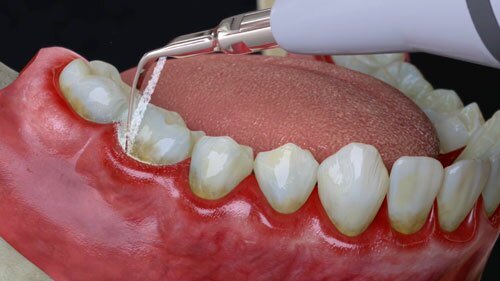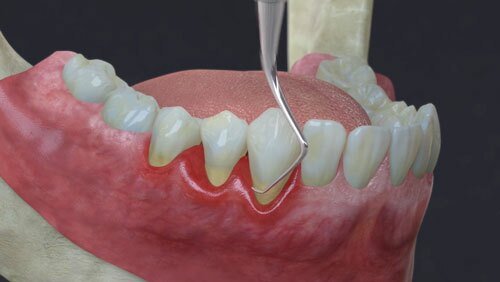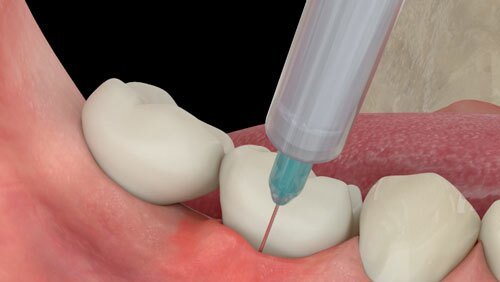Gum disease: Treatment
With careful professional assessment and treatment, it is usually possible to completely halt the progress of periodontitis. The key to success is eliminating the bacterial plaque that triggers the disease process and establishing excellent oral-hygiene practices.
There are six stages in the successful treatment of periodontitis:
1. Oral-hygiene instruction and advice
The aim of the oral-hygiene phase of treatment is to reduce the number of bacteria in the mouth and thereby reduce the level of inflammation. Your dentist will first explain the causes of periodontitis and give you clear instructions on how to keep your teeth and gums clean. You will be given advice on how to use different tools and techniques: for example, the most appropriate tooth-brushing technique and the correct use of interdental brushes, dental floss, and antiseptic mouthwashes. It is important to emphasise that co-operating with oral-hygiene practices is essential for a successful treatment outcome.
2. Professional cleaning
All bacterial deposits (plaque and tartar) are removed from accessible areas of the teeth, and the teeth are then polished and treated with fluoride. If necessary, the dentist will also remove all bacterial deposits and tartar from the root surfaces and gum pockets. A first professional teeth-cleaning can rarely be carried out in a single session. For patients with advanced periodontitis, several appointments for teeth cleaning are necessary.
3. Antibiotic therapy
In some cases, antibiotics are prescribed to deal with active or persistent gum infections that have not responded to oral-hygiene measures.
4. Reassessment
After several weeks (usually six to eight), your dentist or periodontist will make a full assessment of your gums to check the progress of your treatment. A special instrument called a periodontal probe is used to record the depth of any periodontal pockets and check for bleeding from the gums. If periodontal pockets greater than 3mm are still present, further treatment options may be suggested, including corrective surgical therapy.
5. Corrective surgical therapy
In situations with very advanced periodontitis, the deeper gum pockets that remain can generally be successfully reduced only with surgical treatment.
Sometimes, a surgical procedure is carried out to remove plaque bacteria and deposits within periodontal pockets and on the root surfaces at the furcations (where the roots diverge). These areas are inaccessible to brushes and floss, so inflammation will stay there as long as bacteria are allowed to colonise them.
Under local anaesthesia, the gum is raised and the root surfaces are cleaned to ensure that all tartar and plaque accumulations are removed. Sometimes in these cases it is also necessary to remodel bone so that the gums can be properly adapted to the root surface.
Another commonly used approach in treating residual periodontal pockets is regenerative periodontal therapy. This involves using either proteins or bone-replacement grafts and membranes to reconstruct bone that has been lost because of periodontitis. At the end of the procedure, the gums are stitched back into place around the teeth and the stitches are usually left in place for one to two weeks before they are removed.
6. Aftercare - supportive periodontal therapy
The long-term success of periodontal treatment depends on two factors: the patient’s own oral hygiene and regular care from their dentist or periodontist. After the first phase of treatment has been completed, your dentist will need to review the condition of your gums at regular intervals to check that the inflammation has been halted and has not returned. The frequency of your follow-up appointments will depend on the severity of disease and your individual risk of disease progression. Follow-up visits are usually scheduled for every three to six months.
Regular follow-up appointments are vitally important to ensure that periodontitis does not return and cause further destruction of the gums and the bone and ligament that support the teeth. If there are signs of continuing disease, your dentist will be able to treat it at an early stage. You will also be given advice on how to change your oral-hygiene practices to tackle the inflammation.
After gum treatment, long-term success can be ensured only if patients practice optimal oral hygiene at home every day, thus preventing their gums from becoming inflamed again.
Successful periodontal treatment requires your full co-operation in daily oral-hygiene practices and attendance at regular follow-up appointments.
Possible side effects of periodontal treatment
During the professional teeth cleaning, patients may experience pain in very different ways. In general, an inflamed gum is more sensitive than a healthy gum. It is important to know that the entire gum treatment can be carried out under local anesthesia.
Another side effect of gum treatment is the shrinkage of the gum line after professional teeth cleaning. This shrinkage generally leads to the formation of open spaces between the teeth (black triangles) and greater sensitivity of the dental root surfaces to cold temperatures or acidic foods. This greater sensitivity usually goes away after a few months.







